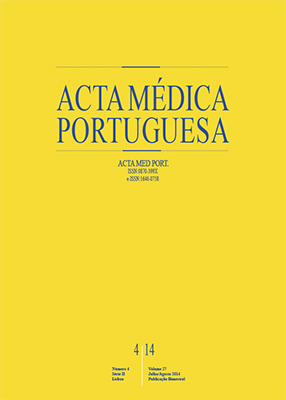Cutaneous Malignant Melanoma: a Retrospective Study of Seven Years (2006-2012)
DOI:
https://doi.org/10.20344/amp.5211Abstract
Introduction: Malignant melanoma is the most aggressive skin cancer and its incidence has been increasing in recent decades. The cure depends on early diagnosis and understanding melanoma epidemiology is of great importance for the implementation of programs of primary prevention and early detection.Material and Methods: We reviewed the clinical cases of primary cutaneous malignant melanoma diagnosed between January 2006 and December 2012 at Centro Hospitalar de São João, in Porto.
Results: An overall of 148 cases of melanoma were analyzed and a female predominance was observed (ratio F:M – 1.6:1). The average age at diagnosis was 61 years. The locations most frequently affected were the lower limbs and trunk. In males the back was the most frequently involved, while in females the lesions occurred preferentially in the legs. Superficial spreading melanoma prevailed in almost all age groups. There was a predominance of thin melanomas and the mitotic index was intermediate (1-6 mitoses/ mm2) in most patients. The ulceration was present in 22.3% of cases and prevailed in thick melanomas as well in nodular subtype. Most patients present at stage IA. There was progression to metastatic disease in 20 patients.
Discussion: The profile of patients with cutaneous melanoma in Centro Hospitalar de São João has characteristics relatively similar to those described in the literature.
Conclusion: The prevalence of thin melanomas, generally with a better outcome, is probably the result of an earlier detection.
Keywords: Skin Neoplasms; Retrospective Studies; Portugal.
Downloads
Downloads
Published
How to Cite
Issue
Section
License
All the articles published in the AMP are open access and comply with the requirements of funding agencies or academic institutions. The AMP is governed by the terms of the Creative Commons ‘Attribution – Non-Commercial Use - (CC-BY-NC)’ license, regarding the use by third parties.
It is the author’s responsibility to obtain approval for the reproduction of figures, tables, etc. from other publications.
Upon acceptance of an article for publication, the authors will be asked to complete the ICMJE “Copyright Liability and Copyright Sharing Statement “(http://www.actamedicaportuguesa.com/info/AMP-NormasPublicacao.pdf) and the “Declaration of Potential Conflicts of Interest” (http:// www.icmje.org/conflicts-of-interest). An e-mail will be sent to the corresponding author to acknowledge receipt of the manuscript.
After publication, the authors are authorised to make their articles available in repositories of their institutions of origin, as long as they always mention where they were published and according to the Creative Commons license.









